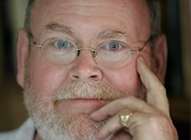The Stanza Lecture: Body of Poetry
 The StAnza lecture is one the mainstays of Scotland’s International Poetry Festival with past luminaries such as Glyn Maxwell, Michael Schmidt, Gillian Clarke and Neil Astley holding forth. It is a tricky juggling act to get right because the lecture is heard by aspiring poets, established poets, academics and poetry readers, as well as folk just off the street who happen to be in St Andrews at that moment wondering what the brouhaha is all about. Needless to say, the fuss around poetry is worth attending to; there is always someone — a whole host of someones — in that line up that you chastise yourself for not knowing well, not re-visiting or not knowing at all. And that real gift of ideas, words and sound doesn’t come along everyday.
The StAnza lecture is one the mainstays of Scotland’s International Poetry Festival with past luminaries such as Glyn Maxwell, Michael Schmidt, Gillian Clarke and Neil Astley holding forth. It is a tricky juggling act to get right because the lecture is heard by aspiring poets, established poets, academics and poetry readers, as well as folk just off the street who happen to be in St Andrews at that moment wondering what the brouhaha is all about. Needless to say, the fuss around poetry is worth attending to; there is always someone — a whole host of someones — in that line up that you chastise yourself for not knowing well, not re-visiting or not knowing at all. And that real gift of ideas, words and sound doesn’t come along everyday.
This year’s speaker, Thomas Lynch, is a distinguished American poet, essayist, short-story writer and funeral director; it is, of course, mention of the latter profession that will prompt that casual incredulous double-take. Yet this unusual combination gives a distinctive perspective. Lynch’s “Bodies of Poetry” lecture, a “why poetry?” talk, touched on the “the slow unfolding of metaphors and mysteries the cipher for which lay just beyond our reach”: the power of language; poetry as liturgy or prayer, marking important milestones such the passage to death; interfaces between faith and poetry or the performative binding and the restorative communion of word and sound integral to both; life’s mysteries addressed by both, not as the “random accretions of happenstance”, but to use a quote from his 2012 collection, The Sin-eater, “the search for meaning, the wonder about the way of things first sidles up to the curious mind”. All of these reflections were leavened by personal anecdotes (about his two grandmothers, about learning Latin for sound before sense); jokes (of StAnza’s director’s introduction: “it is nice to have things said about you in the present tense” or quoting a line from Yeats in relation to his (Lynch’s) discovery of breasts at puberty: “all changed, changed utterly”); and a stubborn desire to honour the small, ordinary moments — the everyday — alongside the miraculous and eventful. In his lecture, the miracle sidestepped, forgotten even, in the parable of the paralytic healed by Jesus at Capernaum is that of the individuals who carried and cared for the man paralysed, “the language of shoulders and aching backs”, “hands on, whole body efforts of human labour”. The miraculous is to be found in our everyday, in the family, friends, the perfect strangers that help to get us to where we need to go; these earthly bonds feed poetry. And, in an extended metaphor, the small ministrations surrounding Seamus Heaney’s stroke (the bearing of his weighty body down the stairs), the funeral cortege that made its way from Dublin to the North for burial, the people who lined the streets to bid their farewells are not only small acts of kindness but rituals of communion, epiphanies and moments of transcendence.
Aspects of Lynch’s lecture, anecdotes, jokes and personal asides as well as his preoccupations with faith and poetry, have already appeared in print in a variety of outlets. The gift of the hour’s labour lay in the performance of those reflections, and in the rhythms and cadences of that performance. The shifts in tone were striking, from the avuncular jovialness and quips of a favourite relation, the conversational warmth, the quiet seriousness of deeper philosophical meditations, to the firm tones and steady conviction of poetic vocation — as well as the puncturing of pretentiousness. All of this in a room full of strangers, variously laughing or hushed. While I am not certain that the aural communion of sound that speaks to the interfaces between poetry, liturgy and faith will signify in the future in quite the way it did in the past (there were young folk in the audience but we were mostly middle-aged), this was — in Lynch’s own words — “common meal”, good for the present. It left us uplifted.
Gail Low
Ed: You can read a review of Thomas Lynch’s collection of essays, Bodies in Motion and at Rest, HERE.

Leave a Reply